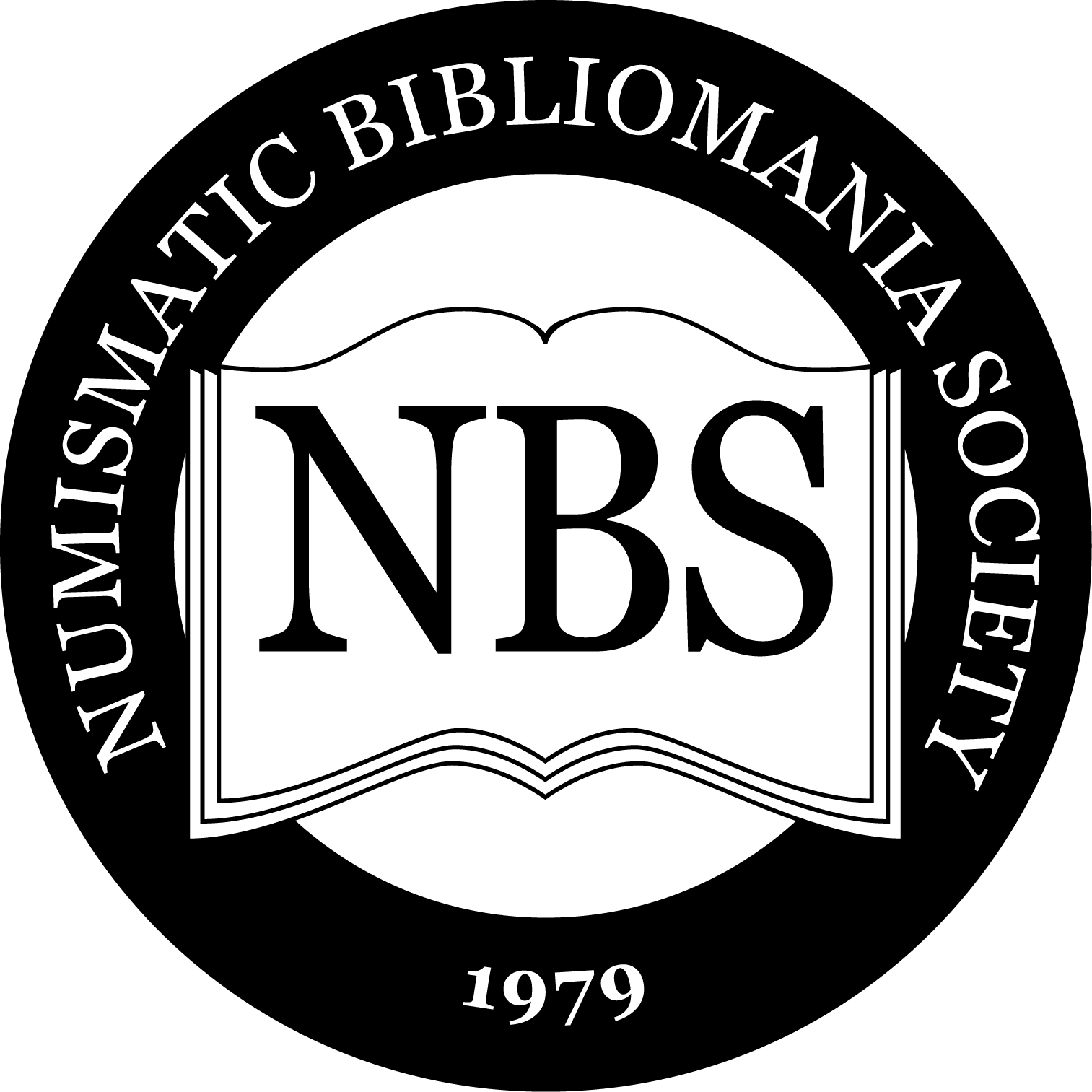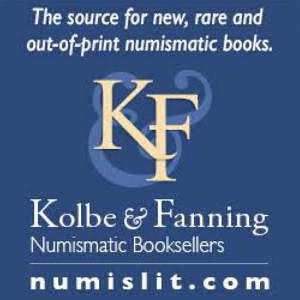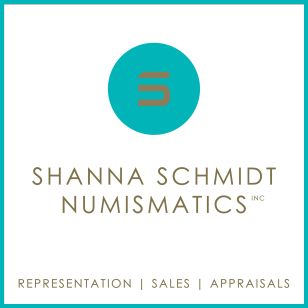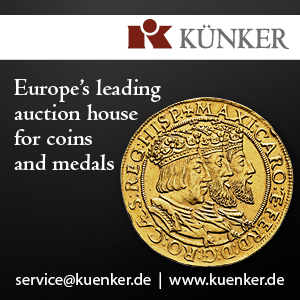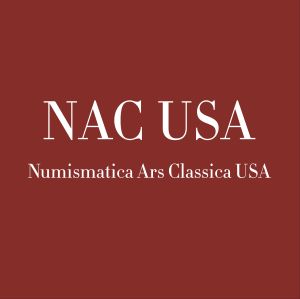Michael Shutterly - ANA 2019
"Buy the Books for the Coin"
Below are images of Michael Shutterly's First Place Exhibit at the 2019 ANA World's Fair of Money in Class 17: Numismatic Literature, Aaron Feldman Memorial. Printed and manuscript (published or unpublished) literature dealing with any numismatic subject.
Photos of the cases are by Wayne Homren with apologies for the reflected lights.
Case 1

Buy the Books for the Coin
The first and best advice most coin collectors receive is "Buy the book before the coin." But why stop with just "the" book? After all, no single book can provide all the information and insights about a coin that a dedicated collector wants or needs.
Let's see how a single coin - in this case, a gold solidus struck by the Byzantine emperor Theophilos - could trigger a collector's bibliomania.
General Guidebooks
The first books our collector would acquire would be general guides to collecting Byzantine coins: she would want to understand just what, exactly, constitutes a "Byzantine" coin. She would start with a pair of books from a pair of experts. The first books our collector would acquire would be general guides to collecting Byzantine coins: she wants to understand just what, exactly, constitutes a "Byzantine" coin in the first place. She would start with a pair of books from a pair of experts.
The Beginner's Guide to Identifying Byzantine Coins by Prue M. Fitts, a founder and the Empress of the Association of Dedicated Byzantine Collectors, covers the coins of the Byzantine Empire from Anastasius I (reigned 491-518) to the fall of Constantinople under Constantine XI (reigned 1448-1453). It teaches the budding collector how to identify Byzantine coins by ruler, by denomination, by mint, and by general type. Fitts explains the meaning of many of the symbols and inscriptions on the coins and provides historical context for them. She also provides guidance on several different ways to collect Byzantine coins and advises on the best methods for storing them. Perhaps most important, the Beginner's Guide includes high-quality photographs and line drawings of representative coins, making it easy to identify them. Our collector's solidus is mentioned but not pictured in the text. This book is currently in print.
Ancient Coin Collecting V: The Romaion/Byzantine Culture is the fifth volume in the Ancient Coin Collecting Series by long-time ancient coin dealer and numismatic writer Wayne G. Sayles. It provides the beginner with a road map for collecting Byzantine coins (which, Sayles notes, is a misnomer: the word "Byzantine" was not applied to the Empire until more than a century after its demise; its citizens were "Romans" to the end). Sayles provides almost encyclopedic information about Byzantine coin denominations, mints, iconography and history; a gallery of emperors and empresses, with a bibliography for each ruler; descriptions of coins struck by other nations imitating Byzantine coins; and 16 "Masterpieces of Romaion Coinage" that demonstrate the artistic heights the coinage could reach. This book is currently in print.
Case 2

Collector Reference Catalogs
Having become well-grounded as a beginner in the field of Byzantine coins, our collector will expand her knowledge by acquiring reference catalogs intended for collectors. She will begin with the earliest catalogs published.
A Handbook of the Coinage of the Byzantine Empire by Hugh Goodacre was originally published in three parts between 1928 and 1933; the parts were collected and published as a single volume in 1957. It covers the coins from Arcadius to Constantine XI, as well as the coins of the Latin emperors (1204-1261) and the emperors of the breakaway states of Thessalonica (1204-1246) and Nicaea (1206-1261).
Goodacre's work was the first reference catalog published in English for collectors of Byzantine coins. In many respects he tracks Sabatier's earlier Monnaies Byzantines, but he goes beyond Sabatier in providing more extensive biographies of the emperors, putting the coinage in better historical context: our collector would learn that Theophilos was a highly cultured, well-educated man who reigned from 829 to 842 as the second emperor of the Amorian Dynasty.
Goodacre identifies our collector's solidus as the product of a "Provincial" mint but does not name the mint. He describes but does not picture the coin, pricing it at £35 (approximately US $152 in 1931, when the pricing was published).
Byzantine Coin Values by Dr. Paul F. Rynearson was originally published in paperback in 1967 with a hardback second edition appearing in 1971; both editions are presented here. The work has long been out of print but can generally be located through numismatic specialty booksellers. Rynearson intended his work to serve as a price guide for collectors. It covers Byzantine gold and silver coins from Arcadius to the end of the Empire but begins coverage of the bronze coins a century later with Anastasius I.
Rynearson lists each emperor's coins by metal, denomination and (major) mint, but does not break out coins by sub-types. This was the first guide to note that the gold coin previously attributed to Manuel II might not be genuine.
Rynearson assigned a rarity level to each coin and estimated its value as of 1971; his rarity levels are still generally valid, but the prices became obsolete long ago. Rynearson identified our collector's solidus as coin #309 and gave it rarity level R3 ("Common"), pricing it at $40 - $65.
Description Générale des Monnaies Byzantines Frappées sous les Empereurs D'Orient, by Justin Sabatier, was the first published catalog dedicated to Byzantine coins. The 1862 first edition is virtually impossible to locate; the second edition (appearing in this exhibit), published in 1930, is a bit easier to find. The French text describes the coins of Emperors Arcadius (reigned 395-408) through John VIII (reigned 1423-1448).
Sabatier based his work on his study of his own collection and the collections of other major collectors, many of whom were his friends or acquaintainces; on his review of the major published works then available; and on his examination of the great collections in the museums in London, Paris, Vienna, Berlin and Copenhagen. Despite the occasional error (he attributed a gold coin to Manuel II, the father of Constantine IX, but Manuel never struck gold coins), our collector will learn a great deal from Sabatier, including how much her coin was estimated to be worth in 1862 (15 francs, or approximately US $8.70; our collector probably paid a bit more for her coin). A solidus of her coin's type is pictured in a line drawing on Plate XLIII, #7 of Volume 2 (the text mis-identifies the location as Plate XLII).
Case 3

Collector Reference Catalogs
After absorbing as much information as she can from the earliest numismatic catalogs, our collector will explore the work of more current researchers.
Le Monete Siciliane dai Bizantini a Carlo I d'Angiò (582-1282) by Rodolfo Spahr covers Byzantine coins struck in Sicily, as well as the coins of the Arabs, the Normans and the Holy Roman Emperors who later ruled Sicily in their turn. This is the standard work on the coins of medieval Sicily, and our collector would be sure to include it in her library. This exhibit displays the first edition Italian text of Spahr's work: long out of print, a copy can generally be found once a year or so, usually at auction.
She will learn from Spahr that Theophilos was the last Byzantine Emperor to strike a gold solidus in Sicily: the island was under attack by the Arabs throughout his reign, and Syracuse, the Byzantine capital and principal mint in Sicily, finally fell to them in 878. Spahr provides photographs of three gold solidi that are similar to our collector's coin, which he cataloged as Spahr 422.
Monete Byzantine di Sicilia by Marco Anastasi was intended to add to, and perhaps surpass, Spahr's Le Monete Siciliane, at least with respect to the Byzantine coinage. Anastasi took a different approach from the writers who came before him: he focused more on the numismatic market itself, consulting coin dealers and reviewing sales and auction catalogs. As a result, his catalog is somewhat less "scholarly" than the others, but it is more attuned to what collectors regularly encounter. Anastasi lists 589 principal Byzantine coin types (Spahr listed 445), with the final coin being a never-before-published bronze of Basil I (reigned 867-886). The Italian text is currently in print.
Anastasi lists several coins of the same general type as our collector's solidus. He dates the coin to 830-831, which is probably a bit too early in Theophilos' reign, but our collector will need to study more to know that. Anastasi estimated the market price for her coin in EF condition (our collector's coin is Mint State, but Anastasi only gives prices for gold coins in EF condition) to be €700 as of 2008, approximately $1,026.
Byzantine Coins and Their Values by David Sear was first published in 1974 and revised and re-published in 1987. Both editions are displayed here: both editions are out of print, and while the second edition can generally be found with specialty numismatic booksellers, the first edition is difficult to locate, especially with its original slipcover. The first edition was the first catalog to include coins of Constantine XI, which first became publicly known just three months before the book was published. That edition listed 2,260 different coin types. The second edition expanded its coverage to include 2,645 coins - virtually every major Byzantine coin type known at the time of publication - with over 600 photographs. Sear covers all the emperors and empresses from Anastasius I to Constantine XI, fully describing each coin and providing each coin's inscription in text fonts similar to those the Byzantines used. Byzantine Coins and Their Values has been the standard catalog for collectors of Byzantine coins since its first publication.
Sear cataloged our collector's coin as Sear 1670 and estimated its value in EF condition at £300 in 1987, equivalent to about US $491. Our collector would learn from Sear that coins of the same type as hers can be found in the collections of the British Museum in London, the Bibliothèque Nationale in Paris, and the Dumbarton Oaks in Washington.
Case 4

Published Collections
The references in Sear’s Byzantine Coins and Their Values to the major museum collections of Byzantine coins would lead our collector to pursue the published catalogs of those collections. While her single coin would be no more than a small speck in one of the great museum collections, it is her speck, and she wants to see how it fits in. She is also interested in the information that those catalogs could provide with respect to her coin.
She would begin with the very first museum catalog of Byzantine coins ever published, the two-volume Catalogue of the Imperial Byzantine Coins in the British Museum.
Presented here is the 1908 first edition of that catalog.

Façade of British Museum
The British Museum is home to one of the world's finest collections of Byzantine coins, including three examples of our collector's coin.Catalogue of the Imperial Byzantine Coins in the British Museum, often cited as "BMC," was written by Warwick Wroth, Senior Assistant Keeper of Coins and Medals in the British Museum. Wroth provides more than 100 pages of background material on Byzantine coins, followed by a detailed catalog of the coins from Anastasius I through the Fall of Constantinople in 1453.
The 1908 first edition of BMC, with the original covers, is presented here. The first edition contains high quality collotype plates of the coins: Wroth was the first to use photographs rather than line drawings of Byzantine coins. BMC has been reprinted by various publishers during the 110 years since its original publication, but the quality of the plates in the original catalog is much better than the quality of the plates in the reprints.
Wroth provided a full verbal description of our collector's coin type (BMC Theophilus 31) on page 424 of Volume II of the catalog; the volume is open to a collotype image of the coin, which appears on Plate XLIX as coin #4 (see top right-hand corner of the plate). Wroth identified the coin as the product of a "Provincial" mint but was uncertain as to the precise location of the mint, suggesting "Sardinia and Sicily may possibly have had a share in it."
Case 5
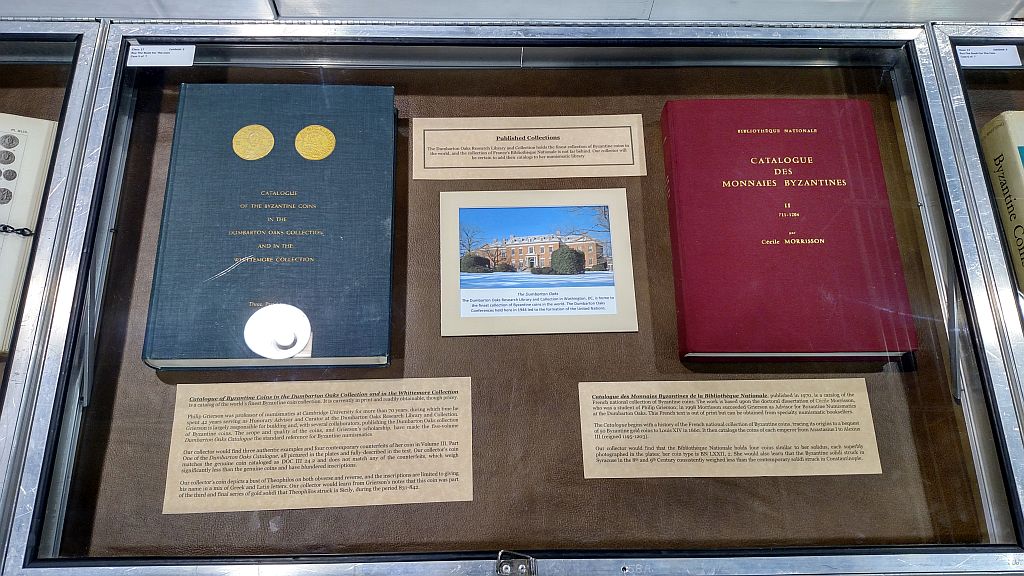
Published Collections
The Dumbarton Oaks Research Library and Collection holds the finest collection of Byzantine coins in the world, and the collection of France's Bibliothèque Nationale is not far behind. Our collector will be certain to add their catalogs to her numismatic library.

The Dumbarton Oaks
The Dumbarton Oaks Research Library and Collection in Washington, DC, is home to the finest collection of Byzantine coins in the world. The Dumbarton Oaks Conferences held here in 1944 led to the formation of the United Nations.
Catalogue des Monnaies Byzantines de la Bibliothèque Nationale published in 1970, is a catalog of the French national collection of Byzantine coins. The work is based upon the doctoral dissertation of Cécile Morrisson, who was a student of Philip Grierson; in 1998 Morrisson succeeded Grierson as Advisor for Byzantine Numismatics at the Dumbarton Oaks. This French text is out of print but can be obtained from specialty numismatic booksellers.
The Catalogue begins with a history of the French national collection of Byzantine coins, tracing its origins to a bequest of 50 Byzantine gold coins to Louis XIV in 1660. It then catalogs the coins of each emperor from Anastasius I to Alexius III (reigned 1195-1203).
Our collector would find that the Bibliothèque Nationale holds four coins similar to her solidus, each superbly photographed in the plates; her coin type is BN LXXII, 2. She would also learn that the Byzantine solidi struck in Syracuse in the 8th and 9th Century consistently weighed less than the contemporary solidi struck in Constantinople.
Catalogue of Byzantine Coins in the Dumbarton Oaks Collection and in the Whittemore Collection, is a catalog of the world's finest Byzantine coin collection. It is currently in print and readily obtainable, though pricey.
Philip Grierson was professor of numismatics at Cambridge University for more than 70 years, during which time he spent 42 years serving as Honorary Advisor and Curator at the Dumbarton Oaks Research Library and Collection. Grierson is largely responsible for building and, with several collaborators, publishing the Dumbarton Oaks collection of Byzantine coins. The scope and quality of the coins, and Grierson's scholarship, have made the five-volume Dumbarton Oaks Catalogue the standard reference for Byzantine numismatics.
Our collector would find three authentic examples and four contemporary counterfeits of her coin in Volume III, Part One of the Dumbarton Oaks Catalogue, all pictured in the plates and fully-described in the text. Our collector's coin matches the genuine coin cataloged as DOC III 24.2 and does not match any of the counterfeits, which weigh significantly less than the genuine coins and have blundered inscriptions.
Our collector's coin depicts a bust of Theophilos on both obverse and reverse, and the inscriptions are limited to giving his name in a mix of Greek and Latin letters. Our collector would learn from Grierson's notes that this coin was part of the third and final series of gold solidi that Theophilos struck in Sicily, during the period 831-842.
Case 6
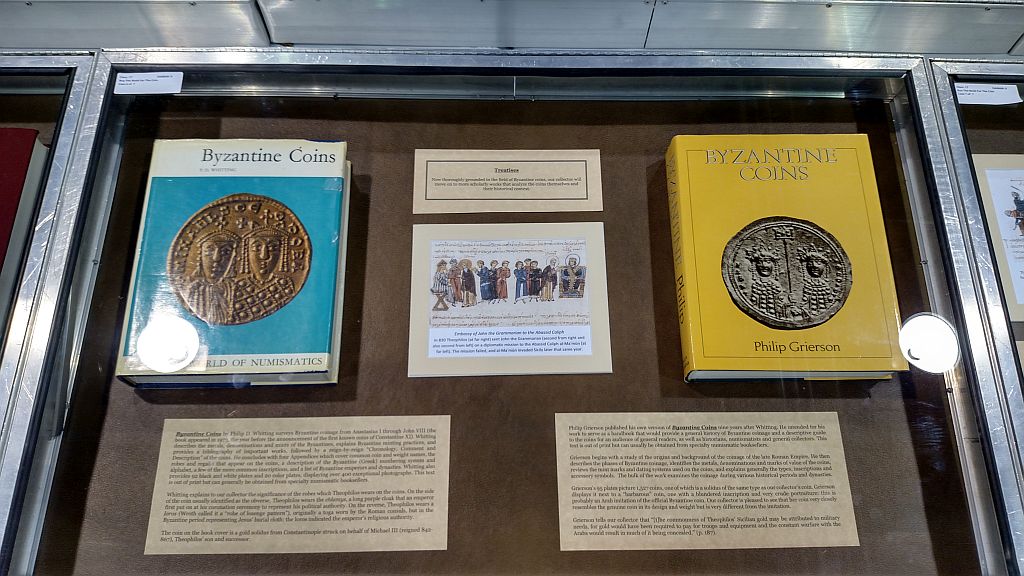
Treatises
Now thoroughly grounded in the field of Byzantine coins, our collector will move on to more scholarly works that analyze the coins themselves and their historical context.
Byzantine Coins by Philip D. Whitting surveys Byzantine coinage from Anastasius I through John VIII (the book appeared in 1973, the year before the announcement of the first known coins of Constantine XI). Whitting describes the metals, denominations and mints of the Byzantines, explains Byzantine minting practices, and provides a bibliography of important works, followed by a reign-by-reign "Chronology, Comment and Description" of the coins. He concludes with four Appendices which cover common coin and weight names, the robes and regalia that appear on the coins, a description of the Byzantine (Greek) numbering system and alphabet, a few of the more common inscriptions, and a list of Byzantine emperors and dynasties. Whitting also provides 92 black and white plates and 20 color plates, displaying over 400 exceptional photographs. This text is out of print but can generally be obtained from specialty numismatic booksellers.
Whitting explains to our collector the significance of the robes which Theophilos wears on the coins. On the side of the coin usually identified as the obverse, Theophilos wears the chlamys, a long purple cloak that an emperor first put on at his coronation ceremony to represent his political authority. On the reverse, Theophilos wears a loros (Wroth called it a "robe of lozenge pattern"), originally a toga worn by the Roman consuls, but in the Byzantine period representing Jesus' burial cloth; the loros indicated the emperor's religious authority.
The coin on the book cover is a gold solidus from Constantinople struck on behalf of Michael III (reigned 842-867), Theophilos' son and successor.
The coin on the cover of the book is a gold solidus from Constantinople struck on behalf of Michael III (reigned 842-867), the son and successor of Theophilos.
Philip Grierson published his own version of Byzantine Coins nine years after Whitting. He intended for his work to serve as a handbook that would provide a general history of Byzantine coinage and a descriptive guide to the coins for an audience of general readers, as well as historians, numismatists and general collectors. This text is out of print but can usually be obtained from specialty numismatic booksellers.
Grierson begins with a study of the origins and background of the coinage of the late Roman Empire. He then describes the phases of Byzantine coinage, identifies the metals, denominations and marks of value of the coins, reviews the mint marks and dating systems used on the coins, and explains generally the types, inscriptions and accessory symbols. The bulk of the work examines the coinage during various historical periods and dynasties.
Grierson's 95 plates picture 1,527 coins, one of which is a solidus of the same type as our collector's coin. Grierson displays it next to a "barbarous" coin, one with a blundered inscription and very crude portraiture: this is probably an Arab imitation of the official Byzantine coin. Our collector is pleased to see that her coin very closely resembles the genuine coin in its design and weight but is very different from the imitation.
Grierson tells our collector that "[t]he commonness of Theophilos' Sicilian gold may be attributed to military needs, for gold would have been required to pay for troops and equipment and the constant warfare with the Arabs would result in much of it being concealed." (p. 187).
Case 7
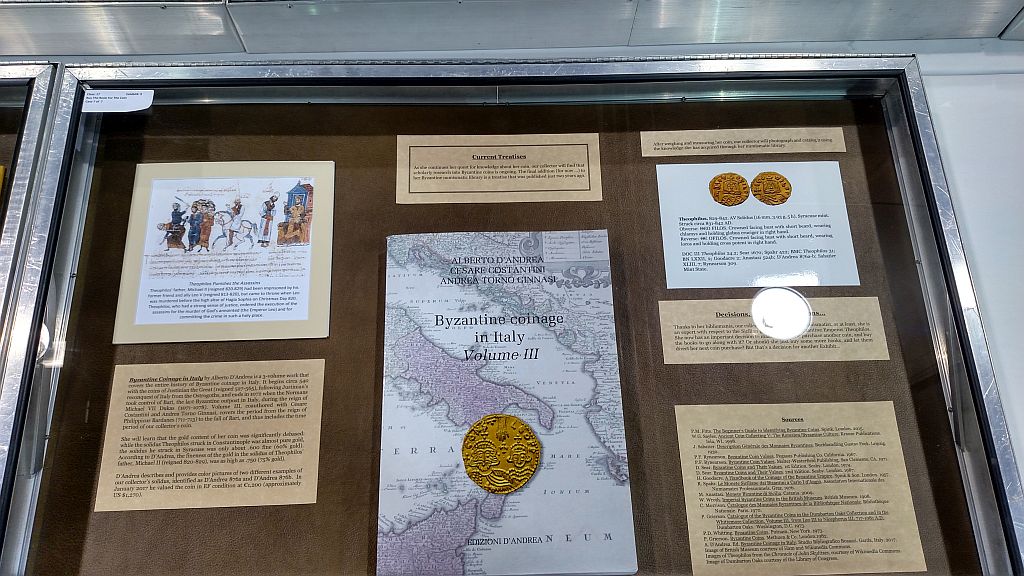
Current Treatises
As she continues her quest for knowledge about her coin, our collector will find that scholarly research into Byzantine coins is ongoing. The final addition (for now …) to her Byzantine numismatic library is a treatise that was published just two years ago.

Theophilos Punishes the Assassins
Theophilos' father, Michael II (reigned 820-829) had been imprisoned by his former friend and ally Leo V (reigned 813-820), but came to throne when Leo was murdered before the high altar of Hagia Sophia on Christmas Day 820. Theophilos, who had a strong sense of justice, ordered the execution of the assassins for the murder of God's annointed (the Emperor Leo) and for committing the crime in such a holy place.
Byzantine Coinage in Italy by Alberto D'Andrea is a 3-volume work in Italian and English that covers the entire history of Byzantine coinage in Italy. It begins circa 540 with the coins of Justinian the Great (reigned 527-565), following Justinian's reconquest of Italy from the Ostrogoths, and ends in 1072 when the Normans took control of Bari, the last Byzantine outpost in Italy, during the reign of Michael VII Dukas (1071-1078). Volume III, coauthored with Cesare Costantini and Andrea Torno Ginnasi, covers the period from the reign of Philippicus Bardanes (711-713) to the fall of Bari, and thus includes the time period of our collector's coin. This text is in print and readily available.
She will learn that the gold content of her coin was significantly debased: while the solidus Theophilos struck in Constantinople was almost pure gold, the solidus he struck in Syracuse was only about .600 fine (60% gold).
D'Andrea describes and provides color pictures of two different examples of our collector's solidus, identified as D'Andrea 876a and D'Andrea 876b. In January 2017 he valued the coin in EF condition at €1,200 (approximately US $1,270).

Theophilus coin obverse and reverse.
Decisions, decisions, decisions…
Thanks to her bibliomania, our collector is now an expert numismatist, or at least, she is an expert with respect to the Sicilian gold coins of the Byzantine Emperor Theophilos. She now has an important decision to make: should she purchase another coin, and buy the books to go along with it? Or should she just buy some more books, and let them direct her next coin purchase? But that's a decision for another Exhibit…
- P.M. Fitts. The Beginner's Guide to Identifying Byzantine Coins. Spink. London. 2015.
- W.G. Sayles. Ancient Coin Collecting V: The Romaion/Byzantine Culture. Krause Publications. Iola, WI. 1998.
- J. Sabatier. Description Générale des Monnaies Byzantines. Buchhandling Gustav Fock. Leipzig. 1930.
- P.F. Rynearson. Byzantine Coin Values. Pegasus Publishing Co. California. 1967.
- P.F. Rynearson. Byzantine Coin Values. Malter-Westerfield Publishing. San Clemente, CA. 1971.
- D. Sear. Byzantine Coins and Their Values. 1st Edition. Seaby. London. 1974.
- D. Sear. Byzantine Coins and Their Values. 2nd Edition. Seaby. London. 1987.
- H. Goodacre. A Handbook of the Coinage of the Byzantine Empire. Spink & Son. London. 1957.
- R. Spahr. Le Monete Siciliane dai Bizantini a Carlo I d'Angiò. Association Internationale des Numismates Professionnels. Graz. 1976.
- M. Anastasi. Monete Bizantine di Sicilia. Catania. 2009.
- W. Wroth. Imperial Byzantine Coins in the British Museum. British Museum. 1908.
- C. Morrison. Catalogue des Monnaies Byzantines de la Bibliothèque Nationale. Bibliothèque Nationale. Paris. 1970.
- P. Grierson. Catalogue of the Byzantine Coins in the Dumbarton Oaks Collection and in The Whittemore Collection, Volume III, from Leo III to Nicephorus III, 717-1081 A.D. Dumbarton Oaks. Washington, D.C. 1973.
- P.D. Whitting. Byzantine Coins. Putnam. New York. 1973.
- P. Grierson. Byzantine Coins. Methuen & Co. London.1982.
- A. D'Andrea, Ed. Byzantine Coinage in Italy. Studio Bibliografico Bosazzi. Garda, Italy. 2017.
- Image of British Museum courtesy of Ham and Wikimedia Commons.
- Images of Theophilos from the Chronicle of John Skylitzes, courtesy of Wikimedia Commons.
- Image of Dumbarton Oaks courtesy of Library of Congress.
